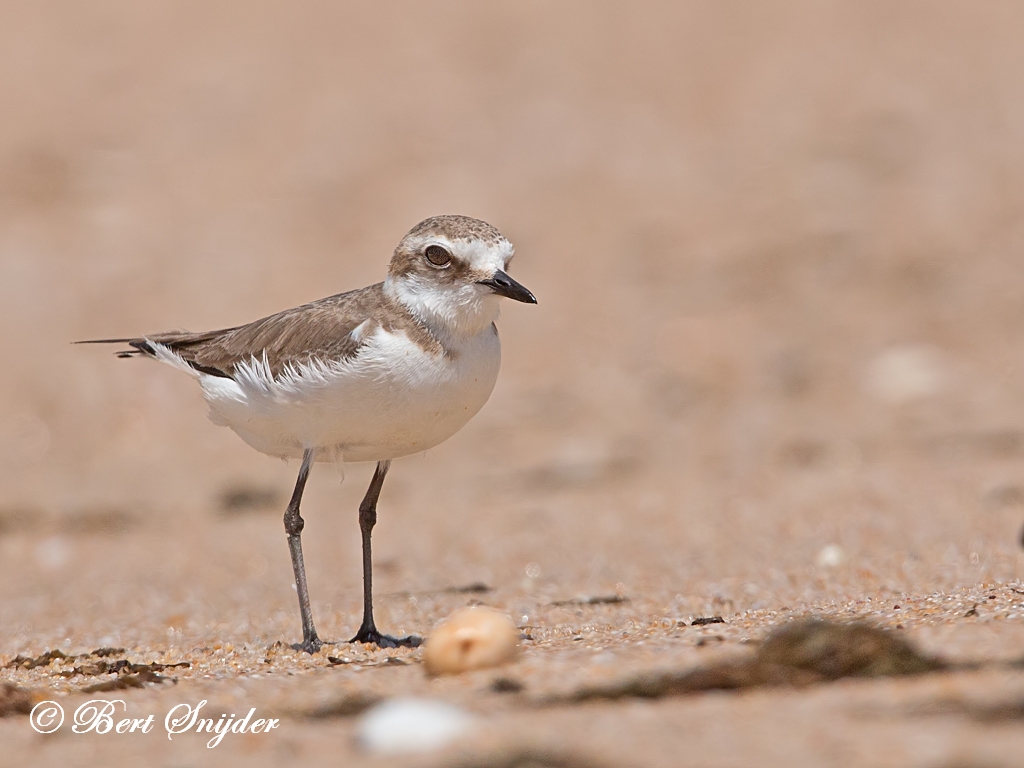Kentish Plover, Strandplevier, Seeregenpfeifer, Borrelho-de-coleira-interompida, Chorlitejo patinegro
Spotted in the Alentejo region of Portugal. Kentish Plover sound
The Kentish Plover (Charadrius alexandrinus) is a small wader in the plover bird family. Despite its name, this species no longer breeds in Kent, or even Great Britain. It breeds in a wide range, from southern Europe to Japan and in Ecuador, Peru, Chile, the southern United States and the Caribbean.

The North American Committee of the American Ornithologists’ Union and the IOC World Bird List have voted on or before July 2011 to split the American forms into a new species Snowy Plover, however, no other committee has voted to change taxonomy yet. In that light, the American forms can now be found under a separate species listing Snowy Plover, however all forms can still be found here until further actions are taken.
The Kentish Plover is 15–17 cm long. It is smaller, paler, longer-legged and thinner-billed than Ringed Plover or Semipalmated Plover. Its breast band is never complete, and usually just appears as dark lateral patches on the sides of the breast. The Kentish Plover’s upperparts are greyish brown and the underparts white in all plumages. The breast markings are black in summer adults, otherwise brown. Breeding males of some races have a black forehead bar and a black mask through the eye. The legs are black. In flight, the flight feathers are blackish with a strong white wing bar. The flight call is a sharp bip.
This species breeds on sandy coasts and brackish inland lakes, and is uncommon on fresh water. It nests in a ground scrape and lays three to five eggs.
The breeding birds in warmer countries are largely sedentary, but northern and inland populations are migratory, wintering south to the tropics. Food is insects and other invertebrates, which are obtained by a run-and-pause technique, rather than the steady probing of some other wader groups.
This bird has six geographical races. The most distinctive are the two that breed in the Americas, collectively called the Snowy Plover. They are shorter-legged, paler and greyer above than the Old World subspecies, and breeding males lack a rufous cap. The eyemask is also poorly developed or absent. Genetic research published in 2009 strongly suggests that the Snowy Plover is a separate species.
The Indian and Sri Lankan breeding form also lacks a rufous cap, and has only a weak eyemask.
The Kentish Plover is one of the species to which the Agreement on the Conservation of African-Eurasian Migratory Waterbirds (AEWA) applies.
The western snowy plover (Charadrius alexandrinus nivosus syn. Charadrius nivosus) breeds from Texas and Oklahoma west to California and up the coastline to Oregon and Washington, with the coastal form’s primary breeding concentration in central and southern California. The Pacific Coast population has been designated a Threatened species under the Endangered Species Act.
In many parts of the world, it had become difficult for this species to breed on beaches because of disturbance from the activities of humans or their animals. The University of California, Santa Barbara, is currently endeavoring to rehabilitate snowy plover populations by protecting beaches along the central California coastline that runs along part of the university campus. UCSB has had some success in encouraging reproduction; the university also often trains students and other volunteers to watch over protected beaches during the daytime to ensure no one disturbs nesting grounds.
Other synonyms:
Afrikaans: Bleekstrandkiewiet, Kentse Strandkiewiet
Asturian: Mazaricu Buro, Mazaricu Pataprieta
Breton: An nouelig pikous
Catalan: Corriol camanegre, Picaplatges camanegre
Catalan (Balears): Picaplatges camanegre
Czech: Kulík morský
Welsh: Cornicyll Caint, Cwtiad Caint
Danish: Hvidbrystet Præstekrave
German: Eurasiatischer Seeregenpfeifer, Seeregenpfeifer
English: Eurasian kentish plover, Kentish Plover, snowy plover, Snowy Plover (Kentish), Western Kentish Plover
Esperanto: marborda pluvio
Spanish: Chorlitejo Patinegro, Chorlito alejandrino, Chorlito blanco, Chorlito Níveo, Chorlo nevado, Kentish Plover, Playero nevado
Spanish (Chile): Chorlo nevado
Spanish (Colombia): Chorlitejo Patinegro
Spanish (Costa Rica): Chorlitejo patinegro
Spanish (Dominican Rep.): Playero Corredor
Spanish (Honduras): Playero nevado
Spanish (Mexico): Chorlito alejandrino
Spanish (Paraguay): Chorlito blanco
Estonian: Meritüll , mustjalg-tüll (meritüll), Mustjalg-tüll e. meritüll
Basque: Corriol camanegre, Txirritxo hankabeltz, Txirritxo hankabeltza
Finnish: Mustajalkatylli
Faroese: Hvíthálsa
French: Gravelot à collier interrompu, Gravelot pattenoire, Pluvier à collier interrompu
Frisian: Dûkelmantsje
Irish: Feadóigín Chosdubh
Galician: Corriol camanegre, Píllara das dunas
Guarani: Mbatuirusu
Haitian Creole French: Ti Plivye blanch
Croatian: Morski Kulik
Hungarian: Széki lile
Indonesian: Cerek Tilil
Icelandic: Strandlóa
Italian: Fratino, Fratino eurasiatico
Japanese: shirochidori, Shiro-chidori
Latin: Charadrius alexandrinus, Charadrius alexandrinus alexandrinus, Charadrius alexandrinus alexandrinus/dealbatus
Lithuanian: Juodakojis kirlikas
Malay: Rapang Pantai
Maltese: Monakella Saqajha Suwed
Dutch: Strandplevier
Norwegian: Hvitbrystlo, Jæderlo
Polish: sieweczka morska
Portuguese: borrelho de coleira interrompida, Borrelho- de-coleira- interrompida, Borrelho-de-coleira-interrompida
Romansh: Gravarel da riva
Slovak: Kulâk morský, Kulík morský
Slovenian: beloceli deževnik, belo?eli deževnik
Albanian: Vraponjësi gushëbardhë
Serbian: Morski žalar, Morski žalar (blataric), morski zujavac
Swedish: Svartbent strandpipare
Swahili: Kitwitwi Ukosi-mwekundu
Travel Birdwatching Holiday Alentejo, Vacation Portugal for birders to see birds on your trip. Guided Birdwatching Tours & Trips.